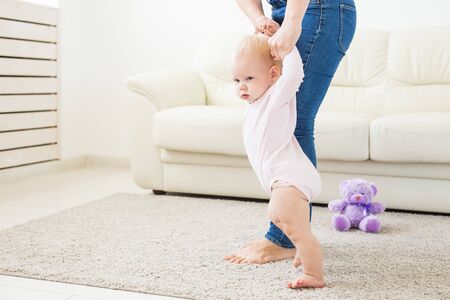Getting Everything Ready
As a new dad in the UK, I quickly learned that being organised before you even start a nappy change can make all the difference. Trust me, when your little one is wriggling and you’re trying to keep things tidy, having everything within arm’s reach is a lifesaver. Here’s what you’ll need and some tips on setting up a safe, comfy changing station:
Essential Nappy Changing Supplies
| Item | Why You Need It |
|---|---|
| Nappies (disposable or reusable) | The main event! Always have at least two to hand in case of surprises. |
| Cotton wool or baby wipes | For gentle cleaning, especially for newborns (NHS recommends cotton wool and water for the first weeks). |
| Nappy bags | To contain odours and make clean-up easy—most UK parents wouldn’t go without them. |
| Barrier cream | Helps protect your baby’s skin from nappy rash, especially during those teething weeks. |
| Changing mat or towel | A waterproof mat or a soft towel keeps things comfy and protects surfaces. |
| Spare clothes | Just in case things get messy—babies love surprises! |
| Hand sanitiser or soap nearby | For quick hand cleaning afterwards—essential when you’re out and about. |
Setting Up Your Changing Station
If you’ve got space at home, set up a dedicated area for nappy changes. A sturdy changing table with raised sides is popular in UK nurseries, but honestly, a mat on the floor works just as well—and there’s no risk of baby rolling off! Make sure everything you need is within arm’s reach; never leave your little one unattended. Keep supplies topped up so you’re never caught short mid-change. If you live in a smaller flat like we do, having a portable caddy with all the essentials makes it easy to move between rooms.
A comfy baby equals a happy change (and less fuss), so I always make sure our changing spot is warm enough, especially during those chilly British mornings. Pop on your favourite playlist or have a special toy handy to keep your baby entertained—it really does help keep wriggles to a minimum!
2. Safely Laying Down Your Baby
Getting your little one settled on the changing mat is a crucial step for a smooth nappy change, especially here in the UK where chilly mornings and wiggly babies are par for the course. First things first, make sure your mat is laid out on a flat, secure surface—never leave your baby unattended, not even for a quick dash for wipes or barrier cream! I always keep everything within arm’s reach before starting; you don’t want to be rummaging around with a half-naked, wriggling baby on your hands.
How to Settle Your Baby
| Step | What To Do | Top Tip (UK Style!) |
|---|---|---|
| 1. Check the Temperature | Ensure the room is warm and the mat isn’t cold—nothing worse than a chilly shock for baby’s bum. | Pop down a muslin cloth if it feels a bit brisk; British weather can be unpredictable! |
| 2. Lay Baby Gently | Hold them securely under their arms and lower them onto the mat, supporting their head and neck. | A gentle “there we go, love” goes a long way to keeping things calm. |
| 3. Distract & Engage | Offer a favourite toy, sing a nursery rhyme, or hang up a mobile above the changing spot. | I swear by Peppa Pig soft toys—works like magic when my little lad gets fidgety. |
| 4. Secure Safety Straps (if available) | If your mat has safety straps, gently secure them over baby’s tummy (but not too tight). | Always double-check they’re comfy—no one likes being squished! |
Why Settling Matters
A well-settled baby means fewer sudden movements, which not only makes cleaning easier but also helps avoid accidents—both wee-related and otherwise. Plus, getting into this habit early sets up positive associations with nappy changes down the line.
Personal Experience:
I found that making eye contact and having a silly chat while laying my son down worked wonders. It’s all about making him feel safe and entertained—sometimes I even get a cheeky grin before the nappy comes off. Remember: calm parent equals calm baby (most of the time!).

3. Taking Off the Dirty Nappy
If you’re a new parent in the UK, facing your little one’s nappy change can feel like a daunting task—especially when it comes to removing that dirty nappy without turning the changing mat into a disaster zone. I’ve been there more times than I can count! Here’s my step-by-step guide to taking off the soiled nappy with as little mess as possible, plus some clever tricks for both boys and girls.
Step-by-Step Guide
- Unfasten the tabs: Gently peel open the nappy tabs. Keep hold of your baby’s ankles with one hand to stop any sudden wriggles (those little legs are surprisingly strong!).
- Lift carefully: For young babies, gently lift their bottom by holding both ankles together and raising them slightly. This makes it easier to slide the dirty nappy out without smearing mess everywhere.
- Front-to-back wipe: Always wipe from front to back, especially for girls, to avoid spreading bacteria. Use the front part of the nappy itself for an initial sweep if there’s a lot of mess.
Clever Tips for Boys and Girls
| For Boys | For Girls |
|---|---|
| Cover his willy with a wipe or flannel to avoid those surprise fountains! | Be extra gentle wiping between all the creases and folds. |
| Point his bits downwards before putting on a clean nappy—helps prevent leaks up the vest. | Always wipe front to back, never back to front. |
Pro Dad Tip
I always have an extra muslin cloth or two on hand—one under my baby just in case things get messy, and another nearby for any unexpected accidents (you know what I mean). If you’re out and about, those disposable changing mats from Boots or Tesco are an absolute lifesaver.
The Bottom Line
The key is preparation and staying calm. With a bit of practice, you’ll be whipping off that dirty nappy like a pro—and trust me, your baby will thank you for those quick changes on chilly British mornings!
4. Cleaning Up Properly
When it comes to cleaning up your little one during a nappy change, doing it properly makes all the difference—not only for comfort but also for preventing nappy rash and other skin issues. Whether you’re at home or out and about in the UK, here’s how to give your baby a proper clean, step by step.
Choosing Your Cleaning Method
Most UK parents use either baby wipes or cotton wool with warm water. Each has its pros and cons, depending on your baby’s skin sensitivity and what’s available. Here’s a quick look:
| Cleaning Method | Pros | Cons | Popular UK Brands |
|---|---|---|---|
| Baby Wipes | Convenient, quick, good for travel | Some may irritate sensitive skin; check for fragrance-free options | Pampers Sensitive, WaterWipes, Huggies Pure |
| Cotton Wool & Warm Water | Gentle on newborn skin; recommended for first few weeks | A bit more effort; not as handy when out | Boots Baby Cotton Wool Pads, Tesco Loves Baby Cotton Wool |
How to Clean Baby’s Bottom Effectively
- Lay your baby safely on the changing mat.
- If using wipes, make sure they are suitable for sensitive skin. For newborns, many health visitors recommend using cotton wool and warm water.
- Start cleaning from front to back—especially important for girls—to avoid spreading bacteria.
- Use a fresh wipe or piece of cotton wool for each swipe to keep things hygienic.
Tackling Nappy Rash: What to Watch For
Nappy rash is a common concern among UK parents. Look out for redness, spots, or sore patches. If you spot early signs of irritation:
- Give your baby some nappy-free time to let the skin breathe (lay them on a towel just in case!).
- Use a barrier cream like Sudocrem or Bepanthen—these are well-loved staples in many British homes.
Top Tip from a Fellow New Dad
I found that having a bowl of warm water ready before I start really helps keep things calm—no scrambling about mid-change! Plus, always have an extra muslin cloth nearby; you never know when there’ll be an unexpected wee!
5. Putting On a Fresh Nappy
Now that your baby is all clean and dry, it’s time to pop on a fresh nappy—one of those moments every new dad in the UK gets to master pretty quickly! Getting the fit just right is key for your little one’s comfort and making sure you don’t have any of those dreaded leaks. Here’s how I do it, step by step, with a few tried-and-true tricks I’ve picked up along the way.
Fit and Fasten: The Basics
| Step | What To Do |
|---|---|
| 1. Slide the fresh nappy under baby | Lift baby’s legs gently by the ankles and slide the nappy under their bottom, making sure the sticky tabs are at the back. |
| 2. Position correctly | The top of the nappy should sit just below baby’s belly button. Make sure it isn’t too high or low—especially for newborns with their umbilical stump still attached. |
| 3. Pull up the front | Bring the front part of the nappy up between baby’s legs, ensuring it sits snugly but not too tight around their tummy. |
| 4. Fasten tabs securely | Stick down each tab at a slight angle for a good fit—think snug, like a comfy pair of joggers, but never so tight it leaves marks. |
A Few Dad-Approved Tricks
- If you’re using disposable nappies, run your finger around the edges of the leg cuffs to pull them outwards—this helps prevent leaks and blowouts (trust me on this one!).
- For cloth nappies, make sure no fabric is poking out; otherwise, you’ll end up with soggy vests before you know it.
- Give your baby a quick tickle or sing a silly song while fastening—distraction is sometimes your best mate during wiggly changes!
Checklist: What to Double-Check Before Dressing Baby Again
- No gaps around the thighs or waist.
- Nappy isn’t too tight or too loose (two fingers should fit easily at waistband).
- No red marks forming on skin from fasteners.
Tip for Out & About in the UK:
If you’re heading out to a café or soft play, always pack an extra nappy or two and some nappy sacks—they’re lifesavers if you need to contain a messy nappy until you find a bin!
6. Dealing with the Nappy After
Handling the aftermath of a nappy change is just as important as getting your baby clean and comfortable. In the UK, weve got our own way of making sure things stay hygienic and odour-free, so here’s my personal routine for sealing, binning, and keeping the changing area squeaky clean.
Sealing Up the Dirty Nappy
Once you’ve wiped your little one and popped on a fresh nappy, it’s time to deal with the used one. Fold the dirty nappy in on itself, using the sticky tabs to seal it shut tightly—this helps lock in any mess and smell. If you’re using reusable nappies, pop them straight into a wet bag or bucket ready for the wash.
Binning Like a Brit
In most UK homes, we use a dedicated nappy bin with a lid to keep odours at bay. Some parents opt for special nappy disposal systems that individually wrap each nappy (like Tommee Tippee Sangenic bins). Here’s a quick comparison:
Nappy Disposal Method |
Pros |
Cons |
|---|---|---|
| Standard Lidded Bin with Liners | Easy, affordable, fits many nappies | May need frequent emptying to avoid smells |
| Nappy Disposal System (e.g., Sangenic) | Individually wraps nappies, excellent odour control | Refills can be pricey |
| Reusable Nappies Wet Bag/Bucket | Eco-friendly, cost-effective long term | Requires regular washing, can get whiffy if left too long |
Keeping the Changing Area Clean and Fresh
I always give the changing mat and surrounding area a quick wipe with antibacterial spray or wipes after every change—especially after those explosive moments! Keeping some hand sanitiser handy is also useful for those times when you’re caught without access to soap and water.
Top Tips for Odour Control:
- Empty your nappy bin daily (don’t wait until it’s overflowing!)
- Add a couple of drops of essential oil or a sprinkle of bicarbonate of soda to the bottom of your bin liner to help neutralise smells
- If using reusables, rinse off solids before storing and run regular hot washes
- Keep windows cracked open if possible for fresh air flow in the nursery or changing area
A bit of extra effort here really makes life easier and keeps your home smelling fresh—trust me, your nose (and guests!) will thank you.
7. Extra Tips from a New Dad
If you’re anything like me, you’ll quickly realise that nappy changes aren’t always as straightforward as they seem—especially when you’re out and about in the UK! Here are some personal stories and practical hacks to help you stay one step ahead, whether you’re at the pub for a Sunday roast or caught off guard on a family day trip.
Changing Nappies on the Go: Real Life Scenarios
| Where | Challenge | My Hack |
|---|---|---|
| The Local Pub | Tiny baby change table, usually next to the noisy hand dryer! | Bring a portable changing mat and use your pram basket to keep all essentials handy. A muslin cloth underneath helps if the surface isn’t spotless. |
| Train Station Toilets | No baby facilities and questionable cleanliness. | Always carry nappy bags and travel wipes. If desperate, find a quiet corner or even your car boot for a quick change (weather permitting!). |
| National Trust Days Out | Unexpected blowouts mid-picnic, miles from the nearest loo. | Pack a full change of clothes in a zip bag, plus extra nappies. Baby grows with zips save precious seconds! |
Essential Kit for British Parents
- A sturdy changing bag – waterproof and easy to clean is a must with our unpredictable weather.
- Pocket-sized hand sanitiser – you’ll thank yourself during festival season or at busy parks.
- Nappy cream – Sudocrem is practically a rite of passage here.
- Reusable wipes – eco-friendly options are gaining popularity across the UK.
Dad’s Top Nappy Changing Hacks
- Always check for “surprise leaks” by running your finger along the nappy edges before heading out.
- Layer up: In colder months, keep an extra vest handy so baby doesn’t get chilly during outdoor changes.
- If you’re worried about mess at friends’ houses, bring an old towel as backup. It keeps everyone relaxed!
Remember:
Nappy changing in Britain can be an adventure—embrace the unpredictability, have a laugh when things go wrong, and never underestimate the power of baby wipes. After all, every messy moment is just another story for the baby book!

